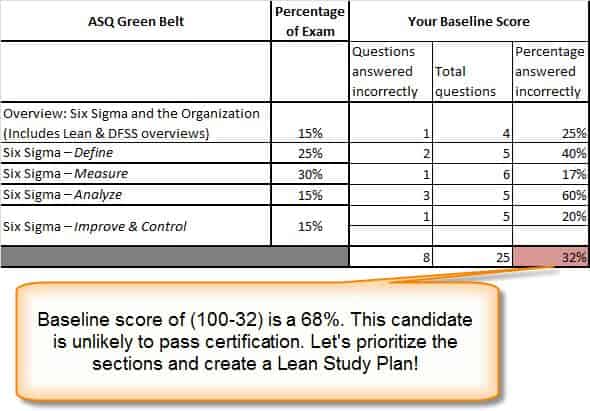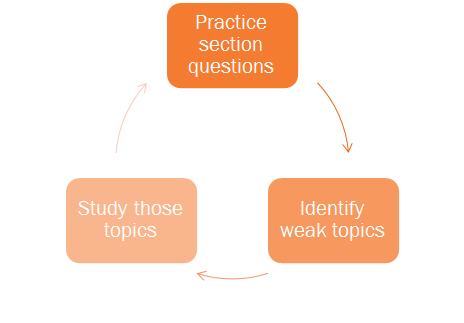In the last lesson you identified which six sigma belt you want to achieve, which organization you want to get certified with, and made a list of topics that you thought you should be studying.
That was the first step to implementing the Baseline Hack strategy.
Here is the high-level overview of how the Baseline Hack works:
Step 1: Find the BOK (that’s Body of Knowledge) for your Six Sigma Belt and Organization.
Step 2: Take a practice exam for that belt & organization.
Step 3: Score each question by topic and subtopic, and determine your area of greatest need.
This strategy works because passing a six sigma exam is about getting the most points possible – not knowing every last thing you were (or weren’t) taught.
Let’s walk through each step in detail.
Step 1: Find the BOK (that’s Body of Knowledge) for your Six Sigma Belt and Organization.
You determined which belt and which organization you want to get certified in in the previous lesson.
That organization lists a Body of Knowledge – a document that states exactly what they will hold you accountable for.
The BOK tells you roughly what will be tested and how much each section is weighted. While each exam is different, they by-and-large test the same things.
Don’t worry about finding yours. I have the majors listed here.
Sometimes these documents are hard to summarize because they are pages and pages long. A recent breakdown of the ASQ and IASSC Green Belt and Black Belt exams based off of their publicly-published materials.
(Note: If you are not sure about your exam’s question breakdown, default to ASQ.)


The goal of this step is to understand roughly what would be a good fit for your customized study plan.
I suggest creating a spreadsheet listing each of the major topics and the percentages you’ll be tested on.
Step 2: Take a practice exam
Take a practice exam for your intended belt & organization. For example, if you are studying to be an ASQ certified Six Sigma Green belt, take that practice exam. If you are studying to become a certified IASSC Black belt, take that exam.
If you want a list of free practice exams that I’ve found, go here.
If you’d prefer to do this on an on-line system, I built one. Sign up here.
Don’t over-think this step.
Just go take the benchmark exam.
Then grade the exam and see how you did for each section.
This step gets you a baseline score per section by taking an example test and scoring by section.
There is no published passing score for the exams. Anecdotal evidence suggests getting a score of above 80% gives you an excellent chance of being certified.
For practice exams, I suggest no less than 90%.
But for now, don’t get caught up in obsessing about what your scores are yet. We are not looking for immediate payoff here. Focus on following these steps. The results will come.
Step 3: Score each question by topic and subtopic, and determine your area of greatest need.
The last part is the most fun.
This is where you determine what you need to study most, and in what order.
We can use the Six Sigma concepts of baseline scores to get an idea of your problem areas. Enter your baseline scores by section into a grid like so.

Optional Prioritization Step
Optional next step, build a prioritization matrix by adding a weighting section. For example, I sometimes like to weight by context where sections earlier in the BOK get weighted higher as they provide context to all of the concepts of Six Sigma, but you can apply any weighting you want.
I say this step is optional because I only suggest doing it if you have scored very low on your baseline exam.
Here’s what this could look like:

Now, Determine your areas of greatest opportunity:
Multiply the Percentage of exam column by the Percentage incorrect column and by the weighting column for a prioritization score for each exam category.
Here’s an example:

In this example, the candidate should work the Define section first as it is the most likely to give him or her the greatest Return on Investment of study time! The Analyze section would be second.
By focusing your efforts on the areas where you have the greatest opportunity, you’ll increase your scores in the shortest amount of study time.
Even better, if you sub-divide your sections, you can make really targeted sections where you can apply very short periods of study for amazing returns.
For example, if the Analyze phase has 8 sections, and only 2 sections are dragging you down, focus there!
Master the questions you are most likely to see on exam day.
Gain exposure to as many targeted problem sets as possible.
Continuing our previous example, the candidate should seek out to master as many Define section practice questions as possible to narrow down specific weak areas.
Then, he or she should study those topics and continue taking practice questions in that section until mastery is achieved.
Now Repeat this process until you score in the range you need to pass the exam!

- It’s time to get to work…
Your action items for today are:
Action Item #1: Take a practice exam (you can find free practice exams here or use my automated system here).
Action Item #2: Hit reply and tell me how you scored on this baseline exam.
Action Item #3: Use the template above to identify which sections you most need to improve upon.
Once you’ve completed these, email me what you’ve come up with!
-Ted
When you finish
..
In the next lesson, I’ll show you two examples of the Baseline Hack in the wild. Real examples of people who have used this strategy to create their own customized study plans and pass their Six Sigma exams the first time as a result.
Here’s a recap of the class so far:
Lesson 1 – The very first step to studying for a Six Sigma exam
Lesson 2 – How to know exactly what will be on your Six Sigma certification exam
Lesson 3 – Behind the scenes of Successful Six Sigma Exam candidates
Lesson 4 – How to Dramatically Increase Your Chances of Passing a Six Sigma Certification Exam
Lesson 5 – Two Examples of How to Use the Baseline Hack Strategy
Lesson 6 – Additional Strategies and Tactics for your Six Sigma Exam
